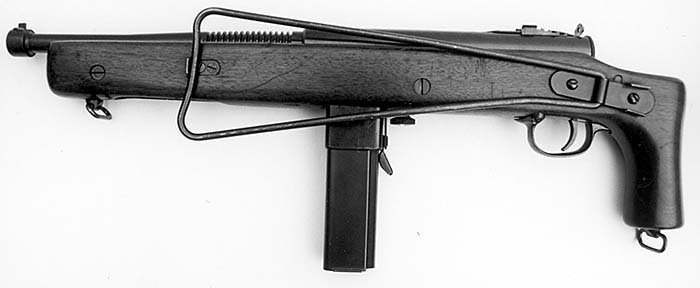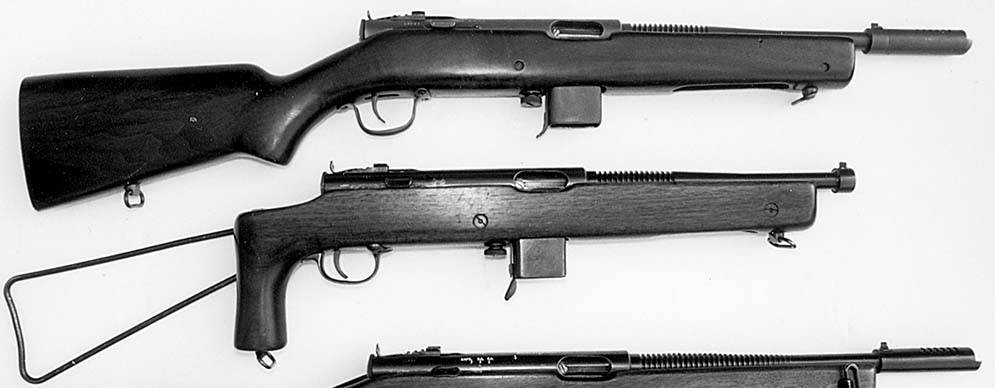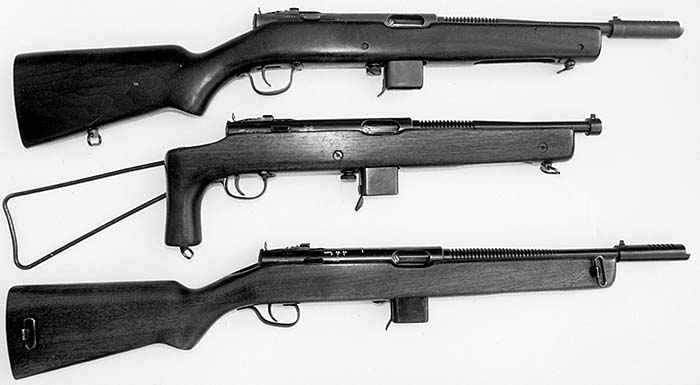By Frank Iannamico
Eugene Reising conceived the Reising submachine in 1938 as a military and police weapon. Harrington & Richardson Arms Inc. began production of the Model 50 in 1940 at their Worcester, Massachusetts factory. Most of the early weapons were sold to police departments and foreign countries, but in 1942 the U.S. Marine Corps adopted the weapon to supplement the few Thompson Submachine guns that they already had in service.
In addition to the full-stocked H&R Reising Model 50 submachine gun there was another variation manufactured, the folding stock “paratrooper” Model 55. A Model 55 Reising is somewhat rare on the U.S. Class III market today, and will often bring double the price of a comparable Model 50.

Model 55 Reisings were not equipped with muzzle compensators. This particular weapon features a 14-fin barrel and a milled 3-screw trigger guard.
After the Marines initially tested the Reising Model 50 submachine guns in 1941, they requested a folding stock version of the weapon. The Marines were looking for a lightweight, compact weapon in which to arm their newly formed airborne troops, the Paramarines. Such a weapon was desired so that upon landing the Marine Paratroopers would have immediate access to a weapon with substantial firepower. Most weapons available to the Marines were too heavy or bulky to carry during a parachute jump. The Reising M55 submachine gun was well suited for the task. The U.S. Army and the Marine Corps also recognized the compact Model 55 as a useful weapon for tank crews, though few were ever issued for that particular purpose. Eugene Reising designed the folding stock of the Model 55, and a patent for the stock was applied for on August 3, 1942. On April 24th, 1945, patent number 2,374,621 was awarded to Mr. Reising for his folding stock design. Harrington & Richardson Arms Inc. requested permission from the Marines in August of 1942 to stamp the word “PARASHOOT” on the receivers of 10 guns in order to copyright that name for the M55 Model. Permission was granted by the Marines to do so.
There was only one other weapon during WWII that was designed especially for use by paratroopers. That weapon was the folding stock version of the M1 carbine, the M1A1.The M1A1 carbine was simply a standard .30 caliber semiautomatic carbine, with a folding wire stock. The paratrooper carbine was similar to the Model 55 Reising in that it was extremely light in weight and compact with the stock folded. The carbine also had a wooden pistol grip that was similar to that of the Reising M55. The M1A1 was first issued in the fall of 1942, a few months after the folding stock M55, but was produced in much larger numbers than the Reising. The carbine used a small .30 caliber round with a 110-grain projectile that was often criticized as having limited stopping power.

A US Marine fires the Model 55 in 1942.
The Reising Model 55 was advertised by Harrington & Richardson Arms for use as a police as well as a military weapon. H&R’s advertisements of the 1940s depicted a police officer firing a Model 55 with the stock folded. “For use in close quarters its advantages are obvious. It can be easily racked under the dashboard of an automobile or it can be carried conveniently by cyclists or mounted personnel”. (Quote from H&R’s 1943 catalog). Few folding stock M55s were ever purchased by the police, most departments sought the more conventional stocked Model 50.
The compact Model 55 was manufactured in both the early “commercial” and later “military” configurations. Many Model 55s were manufactured during the transitional period and have a mixture of both the early and late features. Quite a few of the milled style three screw trigger guards are mounted on M55 stocks. The earliest M55 documented was in the 12,000 serial number range. This was near the end of the early 1st design, two screw trigger guard, 28/29 fin Reising production. Most of the M55s recorded in my research were in the 12,000 to the 95,000 range. Please note that many of the guns that fall within this serial number range were not all Model 55s, many were Model 50’s. Most of the Model 55s documented were marked on top of the receiver Model 55. There were a few early serial numbered guns with M55 stocks marked Model 50 on the receiver. It is impossible to tell if these particular guns were manufactured as M55s or if they were rebarreled and restocked Model 50s. Early Marine documents refer to the paratrooper model as the M50P.
One of the Reising Model 55 examples that were marked Model 50 on the receiver was examined at the Quantico Marine Base located in Virginia. This weapon was serial number 15296, it had a 2nd design receiver and a 1st design M55 28/29-fin 10.5-inch barrel without a compensator, but with an adjustable front sight. This was also the earliest Reising documented with the 2nd design receiver. This weapon had a very worn blue finish, and the finish wear on the receiver matched the wear on the barrel. It is the opinion of the author after examining this weapon that this Reising was originally manufactured as an early M55 using an M50 marked receiver. It is doubtful that this weapon was ever refurbished, if it had been refinished it would most likely have been Parkerized as were most military arsenal rebuilt weapons.
There were 33,500 M55 folding stock Reisings procured by the Marine Corps during WWII. This was from about 120,000 total Reising submachine guns made by Harrington & Richardson Inc. 114,000 were manufactured during WWII, and another 5,483 manufactured in the 1950s. All post WWII Reisings produced were full-stocked Model 50s, in the later “military” configuration.
During research for my Reising book I was contacted by a couple of fellow collectors from New Zealand, Trevor Joyce and Dave McCann. During our conversation they told me that there were a fairly large number of Reisings in the hands of New Zealand collectors, and virtually all of them were the Model 55s. They were quite surprised when I told them that in the U.S. the M55 is quite rare, and the Model 50 rather common. They gave me the serial numbers and features of their guns for inclusion in my book. They had a few 4 digit serial number Reisings that were marked Model 50 on the receiver, but had M55 barrels and early M55 stocks with two screw trigger guards and no lateral tie screws. They also have a very rare 15 round Reising .45 caliber magazine in their possession.
The prototype 15 round capacity magazine was quickly developed for Reising submachine guns that were undergoing Ordnance Department testing at Fort Benning, Georgia. The early manufacture 20 round magazines that were supplied with the weapons were causing too many problems, delaying the testing. The improved design functioned well and the prototype 15 round magazine was increased back to 20 rounds for the production models. Even the “improved” design 20 round magazine began causing problems once they were in the field. In October of 1942, the magazine was redesigned again into a straight-line design that limited the capacity to only 12 rounds and production of the 20 round design was stopped. Plans were made to return all of the existing 20 round magazines to H&R to be converted into the more reliable 12 round straight-line, single-stack configuration.
Approximately 10,000 of the early Model 55s were manufactured with compensators, but in July of 1942, during the third contract (NOm 36828), the Marines requested that the compensators be omitted from future production. Barrels for the Model 55 Reising can be the 28, 29 or 14-fin configuration depending on when the gun was manufactured. Most of the Model 55 barrels are not threaded for a compensator, and the actual overall length is slightly shorter due to the omission of the .5 inch portion of the barrel that is threaded. Otherwise the barrels are manufactured in the same way and of the same materials. The Model 55 barrels were 10.5 inches in length.
The folding stock is one of the major items that make the M55 unique from the more common M50 Reisings. The Model 55 folding stocks came on both the early and late style guns. The folding stocks have been equipped with either the older 2-screw trigger guard and small take-down screw, or the stamped or milled 3 screw trigger guard with the large knurled take-down screw. All M55 folding stocks were equipped with sling swivels mounted on the bottom of the forearm and pistol grip. The early M55 stocks lacked the reinforcing lateral tie screws and were slightly thinner. The metal parts are blued on the earlier versions and parkerized on the later models. The wire portion of the stock is made from stiff wire that is .25 inch in diameter. The stock also has a fairly ergonomic pistol grip made of wood. Many Model 55 Reisings have been noted in vintage wartime photographs with the full Model 50 stocks on them. The M55 folding stocks were fragile and it was frequently reported that the stock would inadvertently fold up during firing. The Reising was certainly easier to fire accurately when equipped with the full carbine style stock. Firing a wire stock Model 55 Reising on full auto from the shoulder for an extended period is quite an uncomfortable experience.
The contents of this article were excerpted from the new book “The Reising Submachine Gun Story” available from Chipotle Publishing 702-565-0746.
| This article first appeared in Small Arms Review V4N3 (December 2000) |












